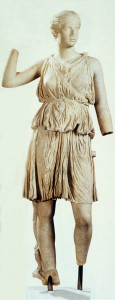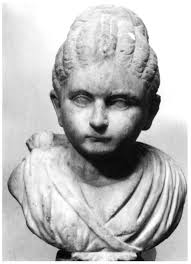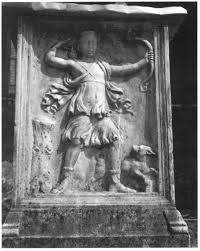
As part of her underworld aspect, Diana was called upon to aid parents during their time of mourning a deceased child. She helped guide them through the grief process as they transitioned from being a parent to being childless. While no literary example exists to prove this, the evidence can be found in portrait sculptures from ancient Rome.
As Eve D’Ambra points out in her article Daughters as Diana: Mythological Models in Roman Portraiture, young girls were sometimes depicted in the guise of Diana in funerary sculptures from the first through the third centuries CE. There are about eleven examples in the form of portrait statues and funerary reliefs. There may have been more than this originally, but it is possible that many were mistaken for the goddess herself 1.
In one portrait from the mid-second century, a little girl between the estimated ages of six and eight is dressed in a chiton and has a quiver strapped to her back. Her physiognomy is the combination of a little girl with chubby cheeks and a mature young adult with a stern brow. Despite her cheeks, this little girl appears strong willed and determined, qualities that would have been celebrated.

Portrait commemoration in ancient Rome served as a memory tool for the living. Adult women were commemorated for being wives and mothers, but since these young girls died before experiencing these rites of passage, commemorating them properly was difficult. “Dying young, these girls lacked the traditional repertoire of female accomplishments (fidelity to a husband and tireless devotion to domestic tasks) that served to praise women in epitaphs; more importantly, they lacked the defining characteristics of the female, that is, the sexual development that begins with marriage and culminates in motherhood” 2. Portraying them in the guise of Diana provided these girls with metaphorical accomplishments that their parents could be proud of. The girls could be remembered as strong and brave like Diana the virgin huntress.
D’Ambra argues that Diana was the perfect model for these young girls for a few reasons. Not only was Diana the epitome of an eternal maiden who never experienced marriage or motherhood, but Diana was also considered a guardian of youths during their transition from childhood to adulthood 3. “Artemis escorts the young to the threshold of adolescence and then leaves her charges as they grow up and take on social identities as citizens and matrons 4. D’Ambra explains that it is Diana’s responsibility because she shares her wild and uncivilized nature with young children 5.

Another sculptural example is a funerary altar that was discovered in the sanctuary at Aricia. This funerary altar depicts a girl of about ten to fourteen years old with a dog at her side as she reaches back to pull an arrow from her quiver. This seen greatly resembles ancient depictions of Diana as huntress.
- Eve D’Ambra, “Daughters as Diana: Mythological Models in Roman Portraiture,” Memoirs of the American Academy in Rome. Supplementary Volumes, vol. 7, Role Models in the Roman World. Identity and Assimilation (2008): 171. ↵
- D’Ambra, “Daughters as Diana: Mythological Models in Roman Portraiture,” 181. ↵
- D’Ambra,“Daughters as Diana: Mythological Models in Roman Portraiture,” 172, 179. ↵
- D’Ambra,“Daughters as Diana: Mythological Models in Roman Portraiture,” 180-181. ↵
- D’Ambra,“Daughters as Diana: Mythological Models in Roman Portraiture,” 180. ↵